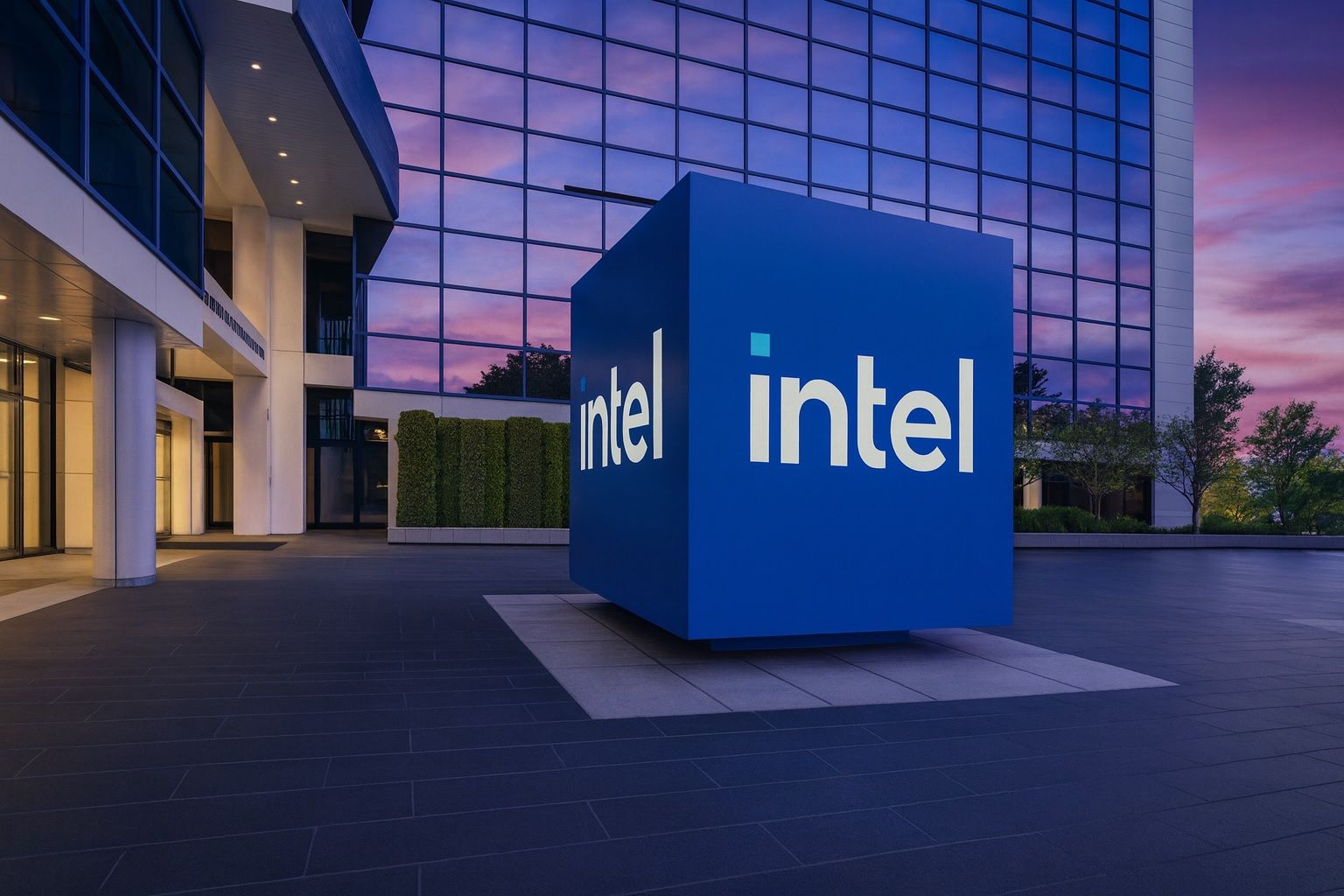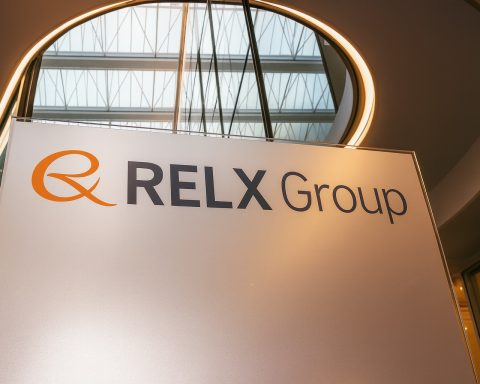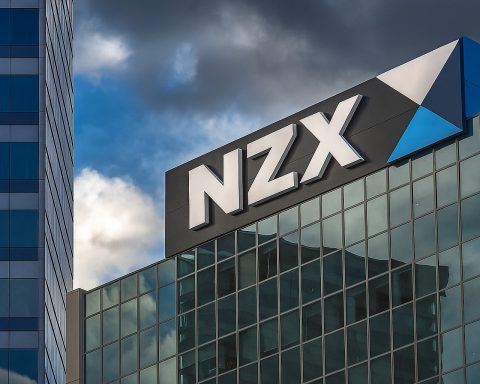Intel Corporation (NASDAQ: INTC) heads into Monday’s U.S. session after one of its most dramatic 12‑month stretches in decades: a government rescue that turned into a 10% federal equity stake, a surprise $5 billion investment from Nvidia, a new CEO, a big AI PC launch, and yet another bruising week for the share price. [1]
If you’re watching Intel stock before the bell on Monday, November 17, 2025, here are the key facts, numbers and storylines to have on your screen.
Quick take: Intel before Monday’s open
- Last close: Intel finished Friday, November 14, at $35.52, down about 1.1% on the day after trading between $34.62 and $35.91. [2]
- Recent pullback: Shares fell about 7.6% over the past week, as investors digested competitive data showing AMD gaining more x86 CPU share and worries about Intel’s earnings trajectory. [3]
- Big picture: Despite the recent drop, Intel is still up roughly 48% over the last 12 months, part of a bigger 2025 rebound after a ~60% plunge in 2024. [4]
- Analyst stance: Wall Street is cautious. MarketBeat data shows an average rating of “Reduce” (effectively a soft Sell) and an average price target around $34.84, slightly below Friday’s close. [5]
- Dividend status: Intel’s dividend remains fully suspended after being halted in 2024; there are no future dividends declared as of mid‑November 2025. [6]
With that context, here are the 10 big things to understand about Intel stock going into Monday’s session.
1. Intel’s recent stock action: rally, reset, and volatility
After a brutal 2024 that saw the stock drop about 60% amid massive losses, layoffs, and a suspended dividend, 2025 has been a comeback year. [7]
- As of mid‑November 2025, several analyses estimate Intel shares are up around 80–90% year‑to‑date, powered by AI hopes, major strategic deals and improving margins. TechStock²+1
- More recently, though, sentiment has cooled. TipRanks notes that INTC fell 7.62% over the past week, with investors growing uneasy about competition from AMD, earnings quality, and dilution from recent capital raises. [8]
In other words: Intel is no longer the deeply distressed single‑digit P/E name of 2024, but it’s also not a smooth “V‑shaped” recovery. Volatility has become part of the story.
2. Q3 2025 earnings: better execution, but guidance stays cautious
Intel’s Q3 2025 results (reported October 23) were meaningfully better than a year ago and beat guidance: [9]
- Revenue: $13.7 billion (up 3% YoY; up 6% sequential; ahead of guidance).
- GAAP EPS: $0.90 versus a loss of $3.88 a year earlier (distorted by one‑offs).
- Non‑GAAP EPS: $0.23, above Intel’s own forecast.
- Non‑GAAP gross margin: 40%, versus just 18% a year ago.
- Operating cash flow: $2.5 billion; adjusted free cash flow about $900 million.
Segment trends matter for the stock:
- Client Computing (PCs): About $8.5 billion in revenue, up 8% quarter‑over‑quarter, helped by a stronger PC market, Windows 11 refresh demand and newer “Lunar Lake” and “Arrow Lake” chips. [10]
- Data Center & AI: Around $4.1 billion, up 5% sequentially, as Intel squeezed better mix and pricing out of its server CPUs. [11]
- Intel Foundry: Roughly $4.2 billion in revenue, but still deeply loss‑making — Q3 foundry operating loss was about $2.3 billion, even though that was an improvement from prior quarters. [12]
The outlook is less rosy:
- For Q4 2025, Intel guides for $12.8–13.8 billion in revenue, GAAP EPS of –$0.14 and non‑GAAP EPS of $0.08, with gross margin slipping back to the mid‑30s. [13]
- A recent Yahoo Finance analysis notes that consensus 2025 EPS estimates have fallen about 67% over the past year, now sitting around $0.31 per share, underscoring how fragile the earnings recovery still is. [14]
What this means for Monday:
Traders will be weighing the stronger recent execution against soft forward earnings power. With such low forecast EPS, headline valuation metrics like trailing P/E (in the thousands) look meaningless and highlight how much of Intel’s current share price rests on optimistic long‑term expectations rather than near‑term profits. [15]
3. A rebuilt balance sheet — thanks to Nvidia, SoftBank and Washington
One reason Intel’s stock didn’t completely unravel in 2024–2025: it found powerful backers.
Massive capital infusion in Q3
According to Intel’s Q3 highlights, the company secured roughly $20 billion in cash during the quarter, including: [16]
- $5.7 billion from the U.S. government, tied to CHIPS‑related funding.
- $2 billion from SoftBank Group, which also exited its Nvidia stake while rotating into Intel. [17]
- Proceeds from selling a 51% stake in Altera and trimming its Mobileye position. [18]
Intel ended Q3 with $30.9 billion in cash and short‑term investments, giving it more breathing room to fund fabs and AI products despite ongoing losses in the foundry business. [19]
The U.S. government now owns 10% of Intel
In September, the U.S. government converted about $11.1 billion in grants and pledges into a 10% non‑voting stake in Intel, instantly making Washington the company’s largest shareholder. [20]
Intel itself has warned in SEC filings that this government ownership carries business risks, including potential backlash from foreign governments and corporate customers who may see Intel as an extension of U.S. policy. [21]
Nvidia’s $5 billion bet
Just as that government stake was being debated, Nvidia announced it would: [22]
- Invest $5 billion in Intel stock at $23.28 per share, taking roughly a 4% stake.
- Partner with Intel to co‑develop custom data center CPUs and x86 “RTX SoCs” for PCs that combine Intel CPU cores with Nvidia GPU chiplets and NVLink interconnects.
The news triggered a ~23% single‑day surge in Intel shares in September — its biggest one‑day jump in nearly 40 years — and was widely described as a “game‑changer” for Intel’s product roadmap, even if it does little to fix the foundry’s economics in the short term. [23]
For Monday: Watch for any new analyst notes or political headlines about the U.S. government stake or the Nvidia–Intel alliance. Both could shift sentiment quickly, especially if investors start to focus more on political and partner risk than on the cash cushion those deals provided.
4. Process roadmap: 18A is here, 14A is the looming question
Intel’s future — and a big part of the bull thesis — rests on whether it can regain process leadership against TSMC and Samsung.
18A ramping at Fab 52
Intel’s 18A node (a 2‑nanometer‑class process) combines new RibbonFET transistors and PowerVia backside power delivery, promising up to 15% better performance per watt and 30% higher density versus Intel 3. [24]
- Intel has already started producing Panther Lake client CPUs and Clearwater Forest server chips on 18A. [25]
- The new Fab 52 in Arizona is now fully operational and expected to reach high‑volume 18A production by the end of 2025, with broad market availability of Panther Lake‑based AI PCs starting in January 2026. [26]
14A: faster, greener — and more expensive
At the same time, Intel’s new CEO Lip‑Bu Tan is weighing a risky pivot: pushing the foundry roadmap toward an even more advanced 14A node that would rely heavily on costly High‑NA EUV tools. [27]
- CFO David Zinsner has confirmed that 14A wafers will be significantly more expensive than 18A, largely due to ASML’s High‑NA EUV scanners, which can cost around $380 million per tool. [28]
- Intel expects 15–20% better performance per watt or 25–35% lower power at the same performance level versus 18A. But management has also warned that 14A only makes financial sense if Intel secures substantial external foundry customers. [29]
For Monday:
Investors will be gauging whether 18A ramp news continues to land positively — or whether markets start to fret more about 14A’s higher costs and uncertain customer pipeline. Any pre‑market commentary about new 18A or 14A design wins (or cancellations) would be a meaningful catalyst.
5. AI PCs and data center CPUs: Intel’s product story into 2026
On the product front, Intel wants to convince investors it’s not just a slow‑growth legacy PC company.
AI PCs: Panther Lake and Core Ultra 3
In October, Intel unveiled Panther Lake, the first AI PC platform built on 18A, branded as Intel Core Ultra series 3: [30]
- Panther Lake is already in production and is set to ramp high‑volume output this year, with broad availability in early 2026.
- These SoCs integrate CPU, GPU and AI accelerators in a multi‑chiplet package, targeting consumer and commercial AI PCs, gaming systems and even robotics solutions. [31]
If the AI PC upgrade cycle takes off — and Intel executes on performance, power and software — this could be a meaningful volume and margin driver over the next 2–3 years.
Data center & AI
On the server side, Intel is preparing Xeon 6+ “Clearwater Forest”, an 18A‑based E‑core CPU promising substantial energy and density gains, scheduled for first‑half 2026. [32]
Meanwhile, the Nvidia partnership positions Intel to:
- Build custom x86 CPUs tightly coupled to Nvidia’s AI GPUs for data centers.
- Compete more directly against AMD’s EPYC line and ARM‑based server CPUs. [33]
For Monday: Any new design‑win announcements, benchmarks, or early OEM chatter around Panther Lake AI PCs or Nvidia‑aligned data center platforms would feed directly into the “Intel as an AI winner” narrative that has powered much of the 2025 rebound.
6. Competitive pressure from AMD and the GPU wars
Even as Intel rallies, AMD and Nvidia are not standing still — and that’s one of the biggest overhangs on INTC.
AMD’s share gains
Fresh Mercury Research data show AMD: [34]
- Reaching 33.6% share of the desktop x86 CPU market in Q3 2025 (about one in three desktop CPUs), up 4.9 points year‑on‑year.
- Climbing to about 25.6% overall x86 share (excluding semi‑custom and IoT), with Intel still ahead at roughly 74.4% but gradually losing ground.
- Benefiting from Intel’s reduced shipments in entry‑level mobile CPUs, even as Intel maintains a strong 78%+ share in laptops.
Recent reports and commentary warn that Intel could lose its long‑time x86 leadership if current trends persist. [35]
AMD’s AI ambitions
At its November Analyst Day, AMD projected that: [36]
- Its data center chip revenue could reach $100 billion annually by 2030.
- Overall earnings might more than triple by 2030, driven heavily by AI accelerators and next‑gen MI400 GPUs.
This aggressive guidance highlights just how crowded the AI‑chip race is becoming — and helps explain why Intel’s stock can sell off even on good news when rival headlines look even stronger.
Nvidia’s position
Nvidia remains the clear AI leader, now valued around $5 trillion in some recent market snapshots, and the new Intel–Nvidia tie‑up is as much about Nvidia extending its ecosystem as it is about Intel catching up. [37]
For Monday: Expect Intel to continue trading partly as a relative trade against AMD and Nvidia. If AMD’s AI or CPU news continues to impress while Intel news is quiet, flows can easily rotate away from INTC, as they did over the past week.
7. Legal and governance overhangs: trade secrets, foundry lawsuits, and politics
Trade secret scandal
Intel has been hit with fresh headlines over an alleged trade secret theft by former engineer Jinfeng Luo, who is accused of taking around 18,000 “Intel Top Secret” files, reportedly including roadmap details. Intel is suing for $250,000 in damages. [38]
TipRanks estimates the story contributed to around a 2% share price dip when it broke, and it reinforces long‑running concerns about IP security in the chip industry. [39]
Foundry lawsuit dismissed — but scars remain
Earlier this year, Intel won dismissal of a shareholder lawsuit that claimed it hid the scale of losses in its foundry business, allegedly contributing to a $32 billion plunge in market value when the truth emerged. [40]
While the court sided with Intel, the case highlighted:
- A $7–13+ billion annual operating loss in Intel Foundry over 2023–2024. [41]
- The decision to suspend the dividend and cut tens of thousands of jobs as part of the turnaround. [42]
Political and regulatory risk
Intel is also enmeshed in geopolitics:
- China has reportedly put Intel in its regulatory crosshairs amid escalating trade tensions, considering antitrust probes and other measures against major U.S. tech firms. [43]
- The U.S. government stake in Intel — while supportive financially — has drawn criticism that the company is becoming a quasi‑state champion, potentially complicating sales in key overseas markets. [44]
For Monday: Any new headlines about:
- Updates to the Luo trade secret case,
- Additional regulatory actions in China, or
- Changes in the political narrative around Washington’s stake in Intel
could move the stock pre‑market, even without new financial data.
8. Analyst sentiment: cautious, with downside skew
Across several research aggregators, the message is broadly consistent:
- MarketBeat shows an average rating of “Reduce” (worse than “Hold”) with a consensus price target around $34.84, slightly below Friday’s close — and a distribution of just 2 Buys, 23 Holds and 8 Sells. [45]
- TipRanks pegs the 12‑month rally at ~47.8% but also warns that analysts’ average price target implies downside from current levels. [46]
Some high‑profile commentators, including TV personalities like Jim Cramer, have urged “caution” on Intel, arguing that while the new CEO and AI strategy are promising, Intel still has to prove it can execute consistently against AMD and Nvidia. [47]
For Monday:
If we see new target changes or rating moves hit the wires pre‑market — especially downgrades or big target cuts — they could reinforce the narrative that Intel has run too far, too fast relative to its fundamentals.
9. Valuation and fundamentals: a tricky mix
Intel’s fundamentals are a bit of a paradox right now:
- Market cap: Roughly $170 billion at Friday’s close. [48]
- Balance sheet: Net cash has improved, with over $30 billion in cash and short‑term investments versus manageable debt, thanks to the Q3 capital influx. [49]
- Liquidity: Quick ratio around 1.25 and current ratio around 1.60 suggest no immediate liquidity crunch. [50]
- Dividend: Still zero, with no reinstatement date in sight — a big change from Intel’s historical appeal as an income stock. [51]
Because earnings are only tentatively recovering and full‑year 2025 EPS is still projected to be slightly negative, traditional metrics like P/E look bizarre (MarketBeat cites a trailing P/E in the thousands). [52]
For many institutional investors, the Intel debate now boils down to:
“Do you believe Intel’s AI‑and‑foundry turnaround will work enough to justify paying a mid‑30s share price before earnings fully normalize?”
That’s why news about 18A/14A yields, design wins, and foundry customer commitments is so critical for the stock.
10. What to watch in Intel stock before the bell on November 17, 2025
Putting it all together, here’s a concise pre‑market checklist for INTC watchers on Monday:
- Pre‑market price & volume
- Is Intel trading materially above or below Friday’s $35.52 close?
- Any outsized pre‑market volume could signal institutional moves reacting to weekend research or macro news. [53]
- Analyst notes and rating changes
- Look for fresh post‑earnings or post‑AMD‑Analyst‑Day notes that revisit Intel’s relative position in AI chips and x86 CPUs. [54]
- Updates on Nvidia–Intel and government stakes
- Any clarification on product roadmaps for the Nvidia partnership (e.g., timelines for RTX‑based x86 SoCs) could be a bullish catalyst.
- Conversely, new political headlines about Washington’s 10% stake — or foreign reactions to it — may weigh on sentiment. [55]
- Process and foundry news (18A/14A)
- Watch for leaks, blog posts or industry reports about 18A yield progress, 14A customer interest, or any hints of write‑downs related to earlier 18A investments. [56]
- Competitive headlines from AMD and Nvidia
- AMD’s continued x86 share gains and aggressive AI growth targets have been a major source of pressure on Intel. Any additional AMD server or GPU wins could extend that trend. [57]
- Legal & regulatory developments
- Any new court filings or updates on the trade secret case against Jinfeng Luo, or signs of Chinese regulatory action related to Intel, could hit the tape. [58]
Final thought: Intel is now a high‑beta turnaround, not a sleepy dividend giant
Heading into the November 17 open, Intel is no longer the stable, high‑yield blue chip many investors remember. It’s a high‑beta turnaround story tied to:
- The success of its AI PC and data center CPU roadmap,
- Execution on 18A and 14A — both as a product engine and a third‑party foundry,
- The impact of unprecedented Nvidia, SoftBank and U.S. government stakes, and
- Its ability to hold off AMD in CPUs while finding its place in the AI accelerator ecosystem.
For traders and investors watching INTC before the bell, the key is to separate headline excitement (big deals, big funding, big promises) from the hard numbers on margins, market share and cash flow that will ultimately determine whether this 2025 rally has legs.
Disclaimer: This article is for informational and educational purposes only and does not constitute financial, investment, tax, or legal advice. Intel stock may be volatile, and you should perform your own research or consult a licensed financial professional before making any investment decisions.
References
1. www.intc.com, 2. www.marketbeat.com, 3. www.tipranks.com, 4. www.tipranks.com, 5. www.marketbeat.com, 6. www.reuters.com, 7. www.reuters.com, 8. www.tipranks.com, 9. www.intc.com, 10. www.alpha-sense.com, 11. www.alpha-sense.com, 12. www.alpha-sense.com, 13. www.intc.com, 14. finance.yahoo.com, 15. www.marketbeat.com, 16. www.alpha-sense.com, 17. www.alpha-sense.com, 18. www.alpha-sense.com, 19. www.alpha-sense.com, 20. apnews.com, 21. www.washingtonpost.com, 22. www.reuters.com, 23. www.barrons.com, 24. newsroom.intel.com, 25. www.intc.com, 26. www.intc.com, 27. www.reuters.com, 28. www.tomshardware.com, 29. www.tomshardware.com, 30. www.intc.com, 31. www.intc.com, 32. www.intc.com, 33. www.reuters.com, 34. www.tomshardware.com, 35. www.theregister.com, 36. www.reuters.com, 37. hwbusters.com, 38. www.tipranks.com, 39. www.tipranks.com, 40. www.reuters.com, 41. iclg.com, 42. www.reuters.com, 43. nypost.com, 44. apnews.com, 45. www.marketbeat.com, 46. www.tipranks.com, 47. www.tipranks.com, 48. www.marketbeat.com, 49. www.alpha-sense.com, 50. www.marketbeat.com, 51. www.intc.com, 52. www.marketbeat.com, 53. www.marketbeat.com, 54. www.reuters.com, 55. www.reuters.com, 56. www.tomshardware.com, 57. www.tomshardware.com, 58. www.tipranks.com







